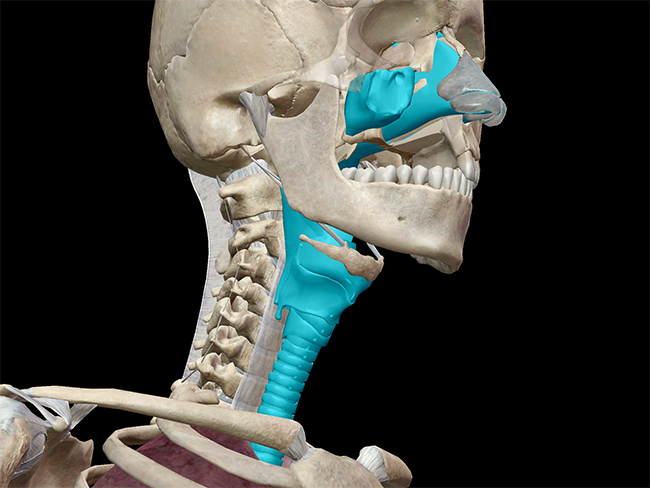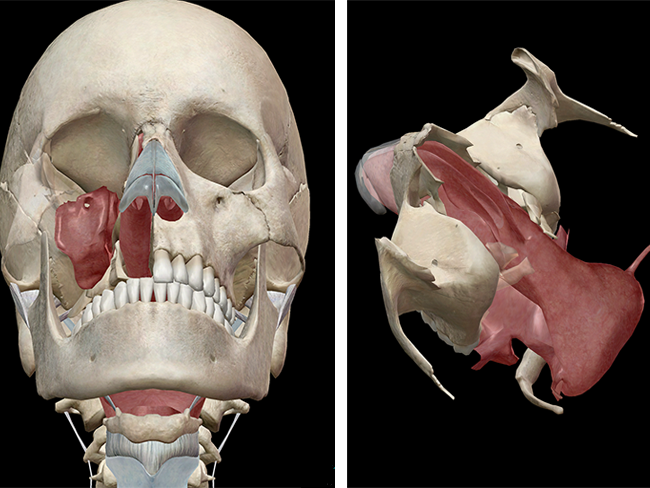Posted on 3/18/13 by Courtney Smith
 Image from Human Anatomy Atlas.
Image from Human Anatomy Atlas.
Breathe in. Feels good to fill your lungs with air and exhale it all out, doesn't it? The structures of your upper respiratory system are always working overtime—filtering air, expelling pollutants, and relying on other anatomy to remain healthy and intact.
Let's take a look at some of the structures and jobs of the upper respiratory system.
Want more respiratory system facts? Check out our free eBook!
 Images from Human Anatomy Atlas.
Images from Human Anatomy Atlas.
The nasal cavity is a chamber of the internal nose that connects to the nasopharynx. Air is inhaled through the nostrils and warmed as it passes through the nasal cavities. There is a mucous membrane that lines the cavity; the mucus helps trap unwanted particles in inhaled air.
Did you know that the nasal cavity is all soft tissue? The bones of the facial skeleton provide structure and support to this tissue. The nasal cavity is supported by the maxillae, ethmoid, palatine, lacrimal, vomer, and nasal conchae.
 Image from Human Anatomy Atlas.
Image from Human Anatomy Atlas.
The ethmoid is perforated with tiny foramina through which branches of the olfactory nerves pass.
Air is inhaled through the nostrils (or, nares) and is filtered by the coarse hairs that line the inside of the nostrils, as well as the mucous membrane that lines the nasal cavities, then warmed and moistened. It continues through the pharynx and larynx, then into the trachea to pass into the lungs.
The air contains the oxygen our bodies need, but sometimes it frequently also carries some allergens, viruses, and/or bacteria into the body. Fortunately, the pharynx contains a number of lymphatic structures: the palatine tonsils collaborate with the nasopharyngeal and lingual tonsils to serve as the “first line of defense” against airborne pathogens. The palatine tonsils contain folds called crypts, which increase their surface area so there is more lymphatic tissue available to fight infection.
 Image from Human Anatomy Atlas.
Image from Human Anatomy Atlas.
The pharynx is a musculomembranous tube that functions as both part of the alimentary canal and an airway of the respiratory system. It is divided into three parts: the nasopharynx, oropharynx, and laryngopharynx.
 Image from Human Anatomy Atlas.
Image from Human Anatomy Atlas.
|
Nasopharynx |
The nasopharynx is the portion of the pharynx that begins at the rear of the nasal cavity. It is perpetually open, unlike its oral and laryngeal counterparts, functioning as an airway in the respiratory system and as part of the alimentary canal. |
|
Oropharynx |
The oral part of the pharynx extends from the soft palate to the hyoid bone. It functions as an airway in the respiratory system and as part of the alimentary canal. In each of its lateral walls is a palatine tonsil; this region also includes the sublingual tonsil under the tongue. |
|
Laryngopharynx |
The laryngopharynx is the posteriormost portion of the pharynx, reaching from the hyoid to the cricoid cartilage. The upper respiratory and upper digestive tracts diverge after the laryngopharynx; the rear of the laryngopharynx merges with the esophagus to continue the digestive tract. |
 Image from Human Anatomy Atlas.
Image from Human Anatomy Atlas.
I have a love/hate relationship with the epiglottis. On the one hand, I think its function in the respiratory system is fascinating; on the other, I loathe it for all the extra work it made me do in my college linguistics course. If I hear the words “glottal stop” ever again, I will not be responsible for my actions.
The epiglottis is a leaf-shaped cartilagous structure that is part of the laryngeal skeleton. It's usually directed upward toward the pharynx, like an open door through which air passes through to the trachea. During swallowing, muscles pull it down to close the entry to the larynx—closing the door, so to speak—to prevent food, liquid, and saliva from entering the trachea.
If you've ever swallowed the wrong way, you've experienced that quick panic and awful seizing in your chest. This is the cough reflex acting to expel whatever you swallowed before it can enter the lungs.
Be sure to subscribe to the Visible Body Blog for more anatomy awesomeness!
Are you an instructor? We have award-winning 3D products and resources for your anatomy and physiology course! Learn more here.
- Anatomy and Physiology: Relationships of the Respiratory System
- Anatomy and Physiology: Gas Exchange
When you select "Subscribe" you will start receiving our email newsletter. Use the links at the bottom of any email to manage the type of emails you receive or to unsubscribe. See our privacy policy for additional details.
©2024 Visible Body. All Rights Reserved.